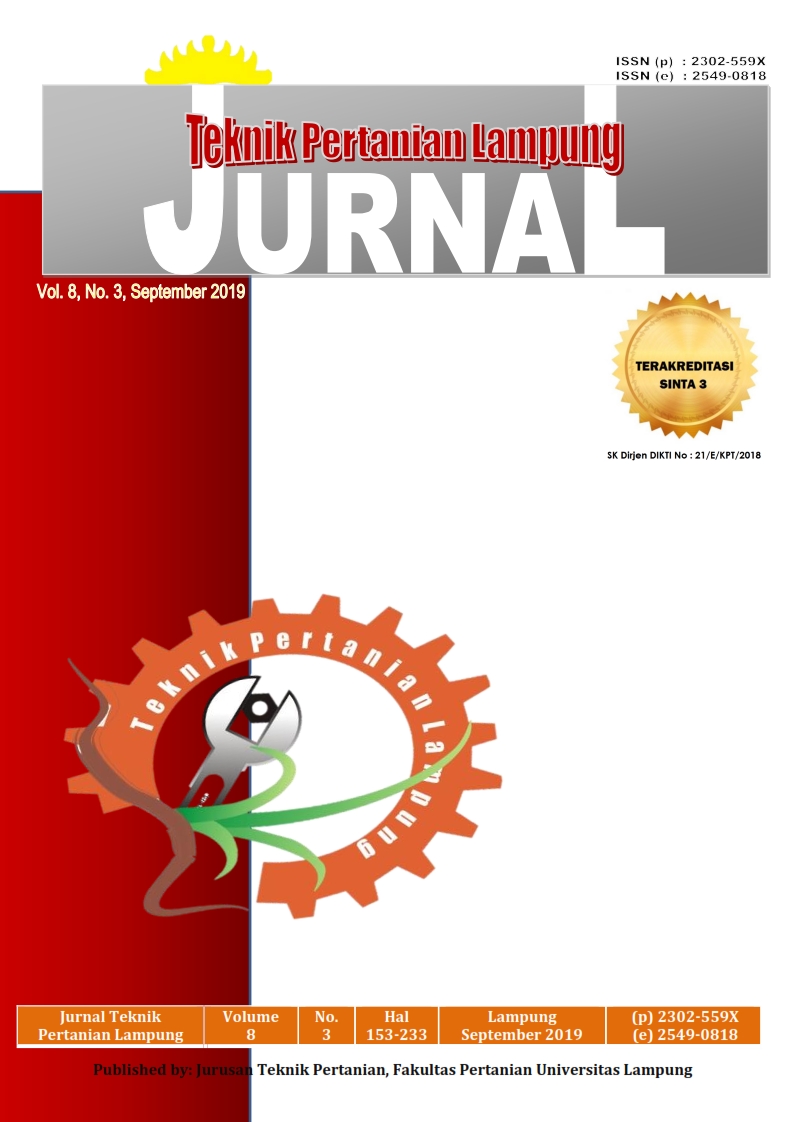EXPLORE THE CHARACTER OF SOIL SPECTRAL REFLECTANCE RELATE TO THE SOIL ORGANIC MATTER CONTENT
DOI:
https://doi.org/10.23960/jtep-l.v8i3.214-223Abstract
ABSTRACTThe visible and near-infrared (Vis-NIR) diffuse reflectance spectroscopy has emerged as a rapid and low-cost tool for extensive investigation of soil properties. The objective of this research was to explore how significant the relationship between the soil spectral reflectance and soil organic matter (SOM) content. Some soil samples in Yogyakarta were taken for SOM content and spectroscopy measurement. The SOM was analyzed using Walkley and Black method, while the spectral reflectance was determined using ASD Field-spectrophotometer by scanned the sample with Vis-NIR spectrum. Pearsons coefficient showed that there was a strong negative correlation between SOM and soil spectral of certain wavelengths. Soil with less organic matter content performed high reflectance.
Keywords: Soil organic matter; Vis-NIR spectroscopy; soil reflectance; Pearsons correlation coefficient.
References
Adamchuk, V.I., B.A. Allred, and R.A. Viscarra Rossel. 2012. Proximal Soil Sensing: Global Perspective. FastTimes. Vol.17: 1. Electronic document www.eegs.org.
Adamchuk, V.I., B. Allred, J. Doolittle, K. Grote, and R.A. Viscarra Rossel. 2015. Tools for Proximal Soil Sensing. In USDA Handbook 18: Soil Survey Manual.
BBSDLP (Indonesian Center for Agric. Land Resources R & D). 2016. Digital map of Nglipar and Dlingo soil scale 1:250,000, Bogor.
Bot, A. and J. Benites. 2005. The importance of soil organic matter. FAO Soil Bulletin 80, Rome.
Christy, C.D. 2008. Real-time Measurement of Soil Attributes Using On-the-go Near-Infrared Reflectance Spectroscopy. Comp. and Elec. in Agric. Vol.61: 10-19.
Conforti, M, R. Froio, G. Matteucci, and G. Buttafuoco, 2015. Visible and Near-Infrared Spectroscopy for Predicting Texture in Forest Soils: An Application in Southern Italy. iForest. Vol. 8: 339-347 URL:http://www.sisef.it/iforest/contents/.
Hedley, C. and P. Roudier. 2010. Proximal Soil Spectroscopy for Soil C Estimation and Mapping. http://www.landcareresearch.co.nz/publications/ newsletters/soil/issue-19/proximal-soil-spectroscopy.
Islam, K., B. Singh, and A. McBratney. 2003. Simultaneous Estimation of Several Soil Properties by Ultra-Violet, Visible, and Near-Infrared Reflectance Spectroscopy. Australian Journal of Soil Research 41 (6): 1101–1114.
Lin, L., Y. Wang, J. Teng, and X. Xi. 2015. Hyperspectral Analysis of Soil Total Nitrogen in Subsided Land Using the Local Correlation Maximization-Complementary Superiority (LCMCS) Method. Sensors (Basel). Vol. 15 (8): 17990–18011. DOI: 10.3390/s150817990.
Rossel, R.A.V., V.I. Adamchuk, K.A. Sudduth, N.J. McKenzie, and C. Lobsey. 2011. Proximal Soil Sensing: An Effective Approach for Soil Measurements in Space and Time. Adv. in Agronomy.Vol. 113: 237-282.
Rossel, R.A.V., J. Bouma. 2016. Soil Sensing: A New Paradigm for Agriculture. Agricultural Systems 148: 71-74.
Sarwono, J. 2006. Metode Penelitian Kuantitatif dan Kualitatif. Graha Ilmu. Yogyakarta.
Sigmund, M. 2005. Introduction to Remote Sensing. https://seos-project.eu/ remotesensing/remotesensing-c01-p05.html.
Stenberg, B., R.A.V. Rossel, A.M. Mouazen, and J. Wetterlind, 2010. Visible and Near-Infrared Spectroscopy in Soil Science. In Donald L. Sparks, editor: Advances in Agronomy Vol. 107: 163-215. Burlington: Academic Press. http://dP.doi.org/ 10.1016/S0065-2113(10)07005-7.
Todd, S.W., and R.M. Hoffer, 1998. Responses of Spectral Indices to Variations in Vegetation Cover and Soil Background. Photogrammetric Engineering & Remote Sensing, Vol. 64, (9): 915-921.
Yin, Z., T. Lei, Q. Yan, Z. Chen, and Y. Dong. 2013. A near-infrared reflectance sensor for soil surface moisture measurement Comp. Electr. in Agric. 99 101–107
Downloads
Published
Issue
Section
License
- Authors who publish with this journal agree to the following terms:
- Authors retain copyright and grant the journal right of first publication with the work simultaneously licensed under a Creative Commons Attribution-ShareAlike 4.0 International Lice that allows others to share the work with an acknowledgement of the work's authorship and initial publication in this journal.
- Authors are able to enter into separate, additional contractual arrangements for the non-exclusive distribution of the journal's published version of the work (e.g., post it to an institutional repository or publish it in a book), with an acknowledgement of its initial publication in this journal.
- Authors are permitted and encouraged to post their work online (e.g., in institutional repositories or on their website) prior to and during the submission process, as it can lead to productive exchanges, as well as earlier and greater citation of published work (See The Effect of Open Access).
Jurnal Teknik Pertanian Lampung

JTEPL is licensed under a Creative Commons Attribution-ShareAlike 4.0 International License.

